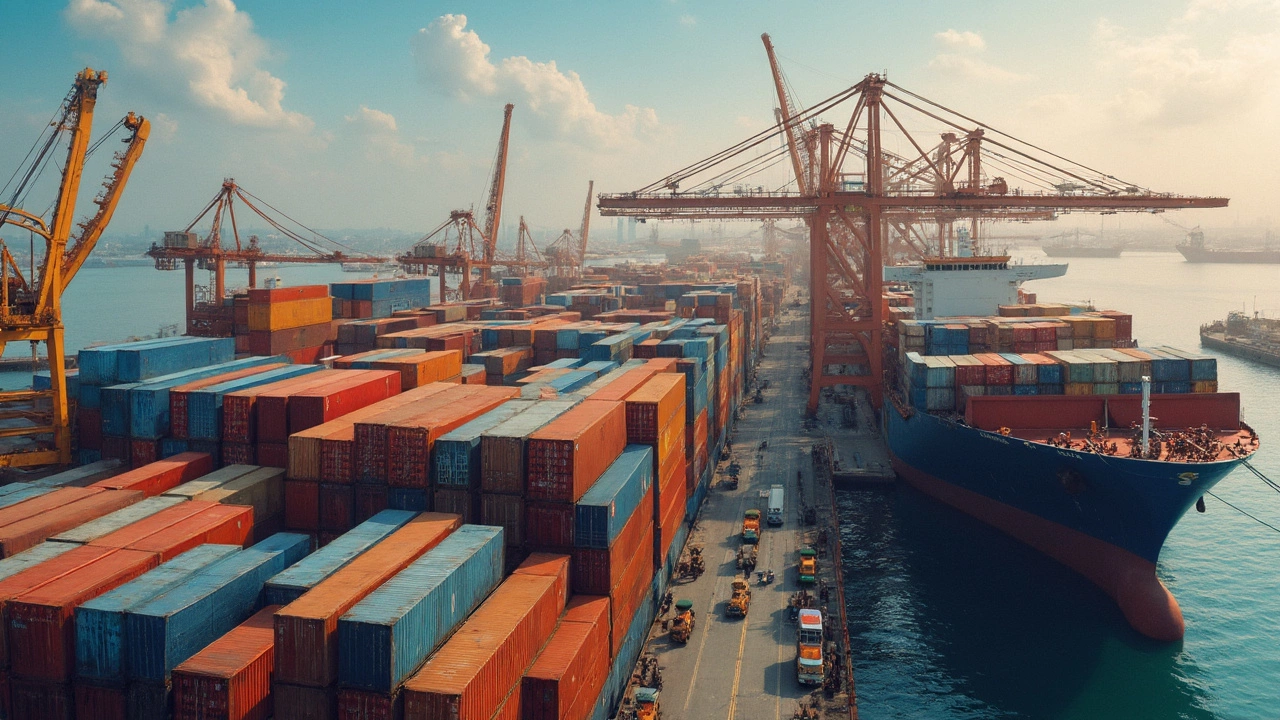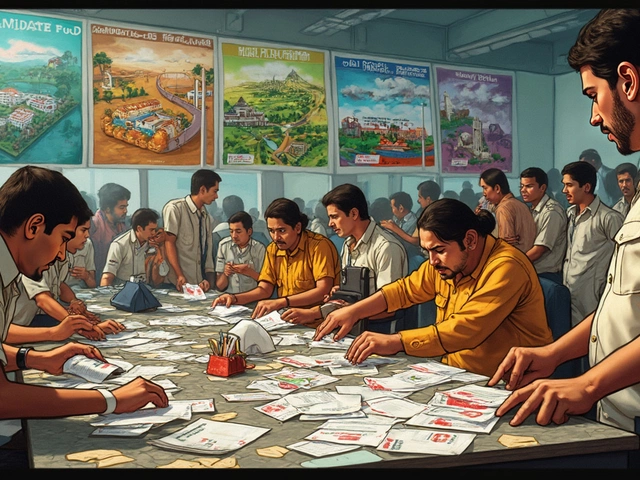Ever wonder how the Indian government manages to fund everything from road repairs to space missions? Let's dig into the fascinating world of government money-making, where taxes and levies play starring roles. Surprise, surprise—taxes aren't the only way the Indian government fills its coffers.
First up, taxes. They're the bread and butter of government revenue. Income tax, goods and services tax (GST), corporate tax—you name it. Whether you're buying a chai or your favorite smartphone, a chunk of what you pay ends up with the government. It's like the ultimate crowdfund for national projects, from building schools to launching satellites.
But things get interesting when you move beyond taxes. Meet excise and customs duties—charging extra for specific goods produced within the country or imported. Ever noticed how imported stuff sometimes costs more? Yep, that's customs in action, designed to protect local industries and boost revenue.
- Taxation: The Backbone
- Excise and Customs: Beyond Borders
- Non-Tax Revenue Sources
- Borrowing and Debt Management
- Public Sector Enterprises and Investments
Taxation: The Backbone
When it comes to government revenue in India, taxation is like the batter in a cake—essential and everywhere. It's the primary means by which the government can fund its services and initiatives. Without taxes, the wheels of governance would come to a screeching halt.
First off, the Indian government collects several types of taxes. The three big ones include:
- Income Tax: This is collected from individuals and businesses based on their earnings. Whether you're a salaried employee or a business owner, there's no dodging this one.
- Goods and Services Tax (GST): Introduced in 2017, GST replaced a bunch of indirect taxes like VAT, service tax, and more. It's a single tax on the supply of goods and services, right from the manufacturer to the consumer. So, every time you grab a pizza, a bit of what you pay heads to the government.
- Corporate Tax: This is what companies pay on their profits. It’s a significant portion of the government's revenue intake, making it a crucial element of India’s economic engine.
Here's a table showing the contribution of major tax categories to the government's total tax revenue for the fiscal year 2024-25:
| Tax Category | Contribution (%) |
|---|---|
| Income Tax | 30% |
| GST | 28% |
| Corporate Tax | 25% |
| Other Taxes | 17% |
But what's amazing is how these taxes help in nation-building. Those taxes you pay pave the roads, build railways, fund education, and even contribute to national defense. It’s like everyone chipping in for a common good! While taxes can feel like a burden, they're crucial for development and progress in any country.
Excise and Customs: Beyond Borders
Imagine you just bought a fancy watch from Italy. Did you know it's not just the watchmaker who's smiling but also the Indian government's bank account? Thanks to customs duties, every imported item like that watch can help boost the country's revenue.
So, what are excise and customs duties really all about? Well, customs duties are like a toll gate tax for goods entering India. They're applied to imports, protecting local businesses by making imported goods a bit pricier. This promotes local industries while also adding money to the government's wallet. It's a win-win!
Now, excise duty, on the other hand, is a tax on goods produced within India. Think of it as a charge for the privilege of making and selling stuff in the country. That soda you grab from the store? Part of what you pay is thanks to excise duty. Both duties together ensure that whether you're buying foreign luxury cars or locally made t-shirts, the government's making a buck or two.
Here's something cool: customs play a vital role in regulating international trade. By adjusting duty rates, India can control trading patterns and safeguard its economy. Some sectors might get lower rates to encourage growth, while others might get higher rates for protection.
To give you an idea of how much this matters, just look at this quick snapshot:
| Type of Duty | Revenue Contribution (in ₹ Crores) |
|---|---|
| Customs Duty | 1,50,000 |
| Excise Duty | 2,50,000 |
Pretty significant, right? Together, these duties aren't just about tax collection but also about shaping the economy. So, next time you spot that 'imported' tag, know that it’s more than just exotic flair. It's a vital part of how the Indian government rakes in revenue to fund everything from roads to rockets.

Non-Tax Revenue Sources
Alright, let's dive into some of the less obvious ways the Indian government makes money. While taxes might be the big players, non-tax revenue sources are like the underdogs that quietly bring in some serious cash.
Ever thought about government-run lotteries? Yep, they're not just for your aunty's New Year dreams. Lotteries are a legit source of income, adding crores to the government's pocket. Then there's dividend income. Imagine the government owning shares in big companies. That's right—it collects dividends just like any savvy investor.
Another source is license fees. Businesses pay to keep their operations legal and regulated in sectors like telecommunications and broadcasting. This is how the government lays claim to its share from private players using public resources.
Don’t forget about fees and fines. Driving a little too fast? Not registering your property? Those fines go straight to the national kitty. Other fees, like court fees or registration fees for businesses, are part of this mix too.
| Source | Contribution to Revenue (Approx %) |
|---|---|
| Dividends & Profits | 20% |
| License Fees | 15% |
| Fees & Fines | 25% |
| Lotteries | 10% |
These non-tax revenue sources might not grab as many headlines as taxes, but they definitely help keep the lights on in a bustling country like India.
Borrowing and Debt Management
Alright, let's talk about borrowing. When the Indian government needs more cash than taxes provide, it often turns to borrowing. Think of it like using a credit card, but on a massive scale. This isn't just grabbing any random loan, though. We're talking government bonds, treasury bills, and securities.
Ever heard of government bonds? They're like those IOUs but fancier. The government promises to pay back the borrowed money with interest. People and institutions buy these bonds, basically lending money to the government with the expectation of earning some interest down the line. This helps in funding everything from infrastructure projects to social schemes.
And, there's debt management. It's all about juggling current debts and planning future borrowing so that it doesn't snowball into a crisis. This is critical because high debt can lead to financial instability. A balanced approach is making sure the country doesn’t drown in debt while still supporting growth.
Take a peek at India's debt numbers, and you'll notice a balanced act. According to recent data, India’s debt to GDP ratio hovers around 70%. Does it sound high? Sure, but it's quite manageable for a growing economy like India.
Borrowing isn’t just about keeping the lights on today. It's also planning for tomorrow. Every penny borrowed is supposed to help generate more value for the people, like through better roads, schools, or tech infrastructure. But like any debt, it's all about managing it smartly, so it pays off without burying future generations in obligations.

Public Sector Enterprises and Investments
When it comes to the Indian government boosting its financial strength, public sector enterprises (PSEs) and strategic investments are like that trusty savings account you dip into for big expenses. They're not just about keeping industry afloat; these ventures are all about contributing to the nation's wallet.
India is home to a variety of public sector enterprises—from the oil giant ONGC to the modest food corporation, FCI. These PSEs operate in crucial sectors like energy, steel, and transportation. The revenue they generate isn't chicken feed. We're talking about billions that lift the government revenue tally, ensuring funds for development projects.
Government revenue in India is also bolstered by stock market action. Yep, when you heard your cousin bragging about shares in a government company, that's not just a family affair—it's part of a larger strategy. Through disinvestments where they sell part of their holdings, the government manages to rake in a handsome sum, which, in turn, funds all things public welfare and infrastructure.
| Sector | Major Companies | Contribution (% GDP) |
|---|---|---|
| Energy | ONGC, NTPC | 5% |
| Telecom | BSNL, MTNL | 2% |
| Banking | SBI, PNB | 3% |
The government's investments in these enterprises aren't just about keeping the lights on. It's about long-term gains, securing jobs, and sometimes bailing out trouble spots to prevent bigger economic woes. This strategic thinking allows the government's money inflow to be as unpredictable as my kid's eating habits—sometimes surprising but reliably impactful.


